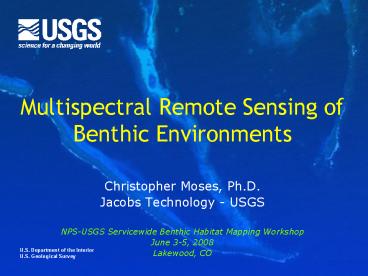Multispectral Remote Sensing of Benthic Environments - PowerPoint PPT Presentation
1 / 21
Title:
Multispectral Remote Sensing of Benthic Environments
Description:
Updated to incorporate revised Visual Identity (VID)System guidelines on fonts. An exception to using the VID fonts is allowed for presentation materials. The font ... – PowerPoint PPT presentation
Number of Views:65
Avg rating:3.0/5.0
Title: Multispectral Remote Sensing of Benthic Environments
1
Multispectral Remote Sensing of Benthic
Environments
- Christopher Moses, Ph.D.
- Jacobs Technology - USGS
- NPS-USGS Servicewide Benthic Habitat Mapping
Workshop - June 3-5, 2008
- Lakewood, CO
2
Outline
- Matters of scale
- Advantages and disadvantages
- Common principles
- Satellites
- Coral reefs applications
3
Scales of benthic mapping
Global ecosystem distribution
Island and coastal geomorphology
Community
Organism
4
Advantages and disadvantages
- Synoptic
- Repeated acquisition
- Possible time series and change detection
- Multi-spectral to hyperspectral
- Calibration and validation
- Expensive
- Clouds
- High-tech issues
- Rapid change, hard to follow literature
- Interpretation
- Products based on many assumptions
- Programming errors
- Unknown calibration problems
- Unknown orbit or sensor errors
5
Electromagnetic Spectrum
A sensor measures the amount of light being
reflected or emitted by the earths surface at
specific wavelengths in the electromagnetic
spectrum
6
Radiative Transfer Theory
Cloud
Atmosphere
Sea Surface
Ocean
7
Temporal resolution
Satellite
Airport
8
Spatial resolution
9
Satellites by name
- Landsat 7 ETM
- 30 m spatial resolution
- 16 day revisit time, identical scene locations,
LTAP - NIR, R, G, B bands
- ASTER
- Advanced Spaceborne Thermal Emission and
Reflection Radiometer - 15 m spatial resolution
- 16 day revisit time
- NIR, R, G (no blue!)
- IKONOS
- 4 m spatial resolution
- Image acquisition by request
- NIR, R, G, B
10
Landsat 7 ETM full scene
180 km
Path 18, Row 48 8 Nov. 2000
11
Landsat 7 ETM Glovers Reef
12
Landsat 7 vs. IKONOS
13
Photo interpretation of Glovers Reef
14
North Florida Reef Tract
15
Supervised habitat classification
Brock et al. (2006)
16
Satellite accuracy (supervised)
- L7 86.2 (2.3)
- 5 classes
- Need class separability
- Sand is most easily misclassified
17
Benthic habitat mapping with airplanes
18
Aerial imagery of BISC
19
Not just for corals!
http//gis.esri.com/library/userconf/proc01/profes
sional/papers/pap900/p90011.jpg
http//www.nasa.gov/centers/goddard/earthandsun/np
s_data.html
20
Summary I
- Advantages of satellites
- Synoptic repeated acquisition multi- or
hyperspectral bands - Disadvantages
- Expensive rapidly evolving technologies
complications of interpretation - Resolution depends on mapping needs
- Temporal and spatial resolution
- Useful satellites for benthic mapping
- Landsat 7 ETM (30 m spatial resolution)
- ASTER (15 m spatial resolution)
- No blue band!
- IKONOS (4 m spatial resolution)
21
Summary II
- Landsat 7 and IKONOS can reach accuracies of gt80
in reef areas - Supervised classification of 5-6 classes
- Satellites and aerial photos reliable to max
depth of 20 m - Particularly useful in reef areas, but also good
for kelp and other near surface habitats































